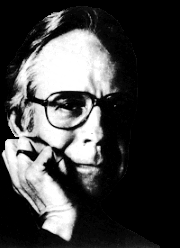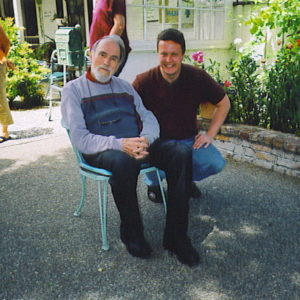While many people helped shape the development of the existential-humanistic psychology movement, two figures stand out, particularly in the United States. While many others, including prominent humanistic theorists, deserve some recognition for their contributions, for now, I will focus on these two figures. These theorists played a prominent role in developing, defining, and promoting existential theory and therapy. Without their leadership, it is doubtful that existentialism would be where it is today.
Rollo May
 Rollo May is considered the father of American Existential Psychology. The beginnings of May’s contributions began with his doctoral thesis which was published in 1950 under the title The Meaning of Anxiety. This book, while not the most exciting read of his books, remains a significant work. In this book, May reclaimed anxiety as an integral part of being human. In doing so, he made several important distinctions regarding anxiety, such as the distinction between neurotic and existential anxiety.
Rollo May is considered the father of American Existential Psychology. The beginnings of May’s contributions began with his doctoral thesis which was published in 1950 under the title The Meaning of Anxiety. This book, while not the most exciting read of his books, remains a significant work. In this book, May reclaimed anxiety as an integral part of being human. In doing so, he made several important distinctions regarding anxiety, such as the distinction between neurotic and existential anxiety.
May’s book Existence, which he edited with Ernest Angel and Henri Ellenberger in 1958, is often recognized as the formal beginning of the existential movement in the United States, and the founding of existential-humanistic psychology. Shortly after Existence, May published a flurry of books over the next 33-years including The Art of Counseling, The Courage to Create, The Discovery of Being, Love and Will, Freedom and Destiny, The Cry for Myth, and Paulus.
The approach to therapy that May developed, while remaining uniquely existential, was influenced by psychoanalytic, humanistic, and Jungian approaches. In reading his case histories, May’s grasp of psychoanalytic theory and technique is evident. Throughout his career, he retained a respect for much of the analytic approach, but departing from it in significant ways. His theory was far more humanistic than the analytic approaches of his time.
May’s conception of the daimonic was another important development in existential thought. The daimonic, for May, was a reworking of Jung’s idea of the shadow. While there are many similarities to Jung’s concept, there are also some significant differences. Diamond (1996) provides an excellent overview of the similarities and differences (See Anger, Madness, and the Daimonic review).
On top of being a brilliant psychologist, May was also a skilled writer. This multifaceted talent helped him promote existential-humanistic psychology. It is hard to go wrong with May’s writings, although I would not recommend beginning with The Meaning of Anxiety. It’s a wonderful book, but not the most enjoyable read of his books, possibly because it began as a dissertation. The three top books I would recommend are 1) Freedom and Destiny, 2) The Cry for Myth, and 3) Love and Will. The most comprehensive overview of May’s theory is likely Freedom and Destiny. Some close to May noted that he did not like this book as he felt that he basically self-plagiarized his previous writings. While, as a writer, this self-critique makes sense, it also is the reason why Freedom and Destiny may be the best overview of May’s writing.
Additionally, there is an entire issue of the Review of Existential Psychology and Psychiatry devoted to the contributions of Rollo May. While these articles are hard to find and do not replace the actual writings of Rollo May, this is an excellent resource on his life and work.
James F. T. Bugental
 Outside of existential-humanistic psychology, Bugental’s influence is not as well known as that of Rollo May and Irvin Yalom, but it is no less significant. Bugental, himself, was influenced greatly by May. In fact, it was May that first drew him to existential psychology and led him to identify the label of existential-humanistic therapy. While Bugental contributed significant writing and theory developments to existential-humanistic psychology, the videos of him doing therapy are equally important contributions as they provide excellent demonstrations and discussions of existential-humanistic therapy.
Outside of existential-humanistic psychology, Bugental’s influence is not as well known as that of Rollo May and Irvin Yalom, but it is no less significant. Bugental, himself, was influenced greatly by May. In fact, it was May that first drew him to existential psychology and led him to identify the label of existential-humanistic therapy. While Bugental contributed significant writing and theory developments to existential-humanistic psychology, the videos of him doing therapy are equally important contributions as they provide excellent demonstrations and discussions of existential-humanistic therapy.
Early in my career, I was blessed to meet and train under Bugental and Myrtle Heery, who has carried on the tradition of his trainings. This opportunity was approximately one-year after he suffered a stroke that has impacted much of his life, including some of his cognitive abilities. However, Bugental still was involved in the training process, largely through providing therapy demonstrations and interviews. In many ways, this provided the ideal situation to demonstrate the incredible power of his approach to therapy. Because of the stroke, he could not be overly cognitive but rather had to stay in the moment, which was the essence of his approach. Bugental’s presence, attentiveness, and concern was the therapy. What occurred to me was that Bugental is more effective as a therapist through his non-verbals, which display his compassion and attentiveness, than many therapists are with their entire arsenals of therapeutic technique.
This example embodies the metaphor of Carl Rogers (1980) that therapy is about “A Way of Being.” While many therapists decrease their effectiveness by trying too hard or becoming overly focused on technique, Bugental is able to display that the most effective therapy is often about a way of being with people that is healing. While much of this seems more humanistic or Rogerian in perspective, part of what distinguishes it is the frame of reference that includes attentiveness to existential issues.
In recent times, theory, especially abstract theory, has come under attack. The question often emerges as to ‘what is the purpose of it?’ and ‘How does it help anything?’ These are important questions. Surely, if there is no benefit to abstraction it is best disregarded. Based on this critique, instructors are commonly now urged to make sure their teaching is practical and involves direct application. However, this is a rather naive position. Abstraction, often because it is better able to stimulate the emotions, impacts one’s way of being and one’s way of perceiving. The rather disheartening changes in the field of psychology that devalue abstract thought narrow one’s perception and understanding of the human experience.
Bugental is the existential thinker who best embodies this. When watching his therapy demonstrations it is amazing how simple it often appears. Yet, for any well-schooled therapist, it is evident that his approach is far from simple. It is the broader awareness, which guided his way of being, that helped him to be effective in a seemingly simplistic manner. A therapist who merely tries to mimic this approach without the foundation of understanding would not be nearly as effective.
In getting to know Bugental’s approach, his books are very helpful. However, to truly understand Bugental’s approach I recommend watching his recorded therapy demonstrations. The videos are available in some university libraries and many can be purchased through Psychotherapy.net.
I have added two links to interviews of Jim Bugental that I think may be of interest. The first is an interview in AHP Perspectives March, 2003. This was one of the last interviews with Jim Bugental before his stroke and discusses his views on death along with his reflections on his career. Click here to read. Second, it an interview by Viktor Yalom on Psychotherapy.net. This interview took place shortly after the release of his book, Psychotherapy Isn’t What You Think, Bugental’s last book of his career. Click here to read. I also wrote a mentor tribute to Jim shortly after he died. Click here to read my tribute to Bugental.
What About Yalom?
Irvin Yalom has had a considerable impact on existential therapy in general, and existential-humanistic psychology in particular. There are two reasons, however, why I would not include him as one of the two primary figures in the development of existential-humanistic psychology. First, Yalom’s influence came later, with his influence on existential psychology largely beginning after the publication of Existential Psychotherapy in 1980. Second, Yalom’s approach, while influencing existential-humanistic psychology, is really his own existential approach. This is not meant as a criticism, but rather an acknowledgment of the differences.
Yalom (1980) did not see existential psychotherapy as an independent, stand-alone therapy. This, in particular, distinguishes it from the existential-humanistic therapy movement. Yalom draws heavily on interpersonal and psychoanalytic therapy in the development of his approach, which is not dissimilar to May. Regardless of whether Yalom could rightly be considered an existential-humanistic therapist, he has made important contributions that have influenced existential-humanistic therapy. Furthermore, of the existential approaches to therapy identified by Cooper (2016), his approach is most similar to existential-humanistic therapy.
Because Yalom is a good writer who writes in an accessible style, he has become very popular and the best-known contemporary representative of existential therapy in the world today. This has benefited all the school of existential therapy. Many who now identify with a particular existential approach other than Yalom’s were first introduced to existential psychology through Yalom. Thus, his work is important in its own right but also has served the broader existential community well.
By Louis Hoffman, PhD
Original version published in 2004
Updated April 2017
